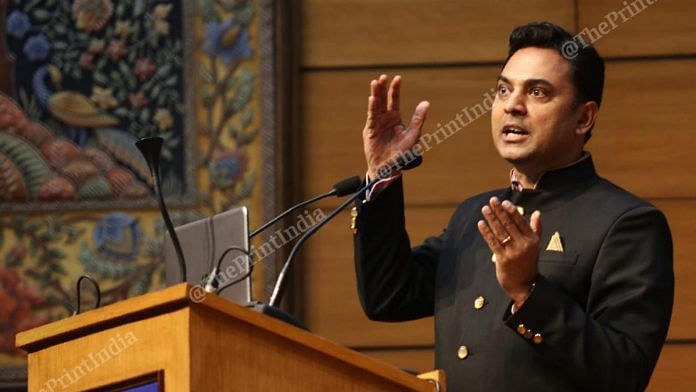New Delhi: At a glance, Chief Economic Adviser K.V. Subramanian’s first Economic Survey may look like a quasi-religious document and not the guide it’s meant to be.
References to Ardhanareshwar, an avatar of Lord Shiva, female scholars like Gargi and Maitreyi mentioned in the Rig Veda, Matsyanyaya, the rule of fish/jungle, and tax evasion and default as sins in Hinduism, Islam and Christianity, abound in the survey tabled in Parliament Thursday.
But Subramanian’s document draws heavily on mythology and religion to convey how deep-rooted religious beliefs can be used to bring in a change in society and elevate the role of women.
Making use of mythology
When he talks about tax evasion and defaults, Subramanian mentions the doctrine of pious obligation and how Hinduism, Islam and the Bible consider these as sins to advocate the use of behavioural economics to make people more compliant.
“In Hinduism, non-payment of debts is a sin and also a crime… Under Islam, Prophet Muhammad advocated — ‘Allaahummainnia’oodhibika min al-ma’thamwa’l-maghram (O Allaah, I seek refuge with You from sin and heavy debt)’… The Bible says, ‘Let no debt remain outstanding except the continuing debt to love one another,’” says the survey.
Subramanian goes on to liberally use mythology to represent the elevated role of women in ancient society.
“Ardhanareshwar — a half male-half female representation of Lord Shiva — captures the equality between men and women. The Rigveda identified many women sages as treasures of knowledge and foresight: the prophetess Gargi, who questioned the origin of all existence in her Vedic hymns and the great Maitreyi, who rejected half her husband’s wealth in favour of spiritual knowledge.
“The long philosophical conversations between sage Agasthya and his highly educated wife Lopamudra are legendary,” says the survey.
It adds that many popular men were identified with their mothers or wives and companions.
“Men in ancient Indian society were identified with their mothers, Yashoda-Nandan, Kaushalya-Nandan, Gandhari-Putra, as well as their wives/consorts, Janaki-Raman, Radha-Krishna.”
In his creative interpretations, the CEA also draws an equivalent between ending Matsyanyaya and filling up vacancies in lower courts and high courts to clear the backlog of cases.
Also read: ‘Nudge’ is the secret behind success of Modi’s pet projects, says Economic Survey
How Subramanian wants to bring about social change
The survey uses many interesting phrases and acronyms to effectively put across its point for the need for more economic and social reforms and a change in mindset across sectors.
Rivalling the terms coined by his predecessor Arvind Subramanian in his 4 economic surveys in the last four fiscals, the CEA’s document uses terms like ‘Badlav’, ‘Sundar Bharat’ and ‘nourishing dwarfs to become giants’.
Subramanian suggests moving from ‘Beti Bachao Beti Padhao’ to ‘BADLAV’, or ‘Beti Aapki Dhan Lakshmi Aur Vijay Lakshmi’, as part of the ambitious agenda for social change for emancipation of women.
He also advocates moving from ‘Swachh Bharat’ to ‘Sundar Bharat’ for a more hygienic country, and from a ‘Give it up’ stance for the LPG subsidy to ‘Think about the Subsidy’ position.
On the issue of removing incentives that encourage micro, small and medium enterprise to stay small, the CEA pushes for the need to “nourish dwarfs to become giants” by doing away with size based incentives that encourage these firms to not increase their size.
In his economic surveys between 2014-15 and 2017-18, some of the interesting acronyms coined by former CEA Arvind Subramanian included the ‘4Rs’ (2015-16 survey) — Recognition, Recapitalisation, Resolution, and Reform — to resolve the twin balance sheet problem, and the JAM trinity (2014-15 survey) — Jan Dhan Yojana, Aadhaar and mobile number — to ensure targeted delivery of subsidies.
Also read: Cut court holidays — now even Economic Survey wants higher judiciary to work more




I had listened to Chief Economic Adviser (CEA), Dr Krishnamurthy V. Subramanian (KVS) speech at the press conference. I was really disappointed hearing KVS who seems to be pushing his theories based on USA or China’s economy. His understanding of India’s SMEs looked very distorted when he tried to compare them with USA.
I am further disappointed that KVS is also educated in economics in USA and done his PhD under Raghuram Rajan. It looks Modi is appointing CEA with USA background for the left intellectuals. It looks a waste of money on economic surveys by people who have little understanding of Indian economy.
After exit of scholarly Arvind Subramaniam, there was definitely a lot of curiosity about the other Subramiam’s first Economic Survey document. IT must be said that he is quite impressive with his ideas and presentation. Of course, the devil lies in their implementation! Hopefully, government will implement his ideas of tapping foreign capital and lowering cost of capital to boost investments in the economy and treating data as public good, Interestingly ( and surprisingly), he has no comments to offer on agriculture sector which is languishing from implementation of common sense ideas like land leasing ( and not acquisition), land record to be made available online, collective or corporate farming ( thereby attracting technology and capital),, free movement of produce, freedom from APMC mandis etc. For last 15 years, one hardly noticed any contribution by then agriculture ministers, Sharad Pawar and Radha Mohan Singh. Reforms in agriculture can release land for industry and rejuvenate agrarian economy greatly and reduce rural distress greatly. Overall, from his presentation, one gets a sense of KVS being a much more grounded person and this is a welcome sign.
Very impressive. Brings to mind Commodore Perry’s visit to Japan in 1853 – 54, forcing an ancient civilisation to modernise rapidly. The Japanese held on to their cultural and spiritual core, while equalling and then almost surpassing the West in economic growth and modernisation. All this rootedness in the past works best when it is not at the cost of a scientific temper and an embrace of globalisation. One hopes India will be able to strike the right balance between what can often become powerful opposing forces.